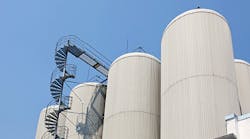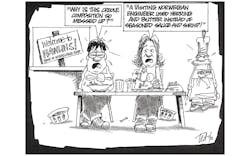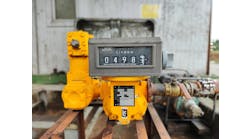This Control Talk column appeared in the August 2022 print edition of Control. To read more Control Talk columns click here or read the Control Talk blog here.
Read Part 1 of this article here.
Greg: Before we welcome Mark Darby back to our conversation, I want to provide a heads-up on the most common mistake in tuning column temperature and level controllers, which is too small of a reset time or too small of a proportional-integral-derivative (PID) gain, resulting in slow rolling oscillations with exceptionally long periods (hours to days for temperature and minutes to hours for level). Most people don’t realize that the product of the controller gain and reset time must be greater than 4 times the inverse of the integrating process gain to prevent slow rolling oscillations. We often find the integral time must be increased by two or more orders of magnitude to stop the oscillations. This problem originates from the near-integrating response of the temperature loop and the true integrating response of the level loop when these controllers are manipulating a distillate or reflux flow. The open-loop near-integrating process gain for the temperature controller is the dimensionless open-loop process gain seen by the PID working with percent signals divided by the open-loop time constant, resulting in a near integrating process gain that is typically less than 1 / 105 sec. To avoid the setpoint (SP) kick, some mistakenly reduce the controller gain and decrease the integral time, which can lead to this problem. The best solution is to use a two-degree-of-freedom controller, or select algorithm with proportional on PV, or apply a SP filter discussed in the Control Talk column "The concealed PID revealed, part 3."
Mark, how do you decide on a proper strategy for composition control?
Mark: The key factors that go into a decision are: 1) desired product purities 2) whether dual-point composition control is required (i.e., control of both column product streams) and 3) the nature of typical disturbances. Before going further into some of these considerations, it is useful to describe the basic strategies. In the following configurations, the manipulated variables for temperature and/or composition control are indicated. The naming of the schemes in terms of internal variables L and V reflects common usage in the literature, where L is the internal liquid at the top tray and V is the internal vapor from the reboiler. The use of these variables reminds us that while a control scheme will be manipulating external variables, the internal variables determine product compositions.
- Reflux/Reboiler (LV Configuration). Energy balance scheme. Reflux drum level is controlled by distillate and bottoms/sump level by bottoms.
- Distillate/Reboiler (DV Configuration). Material balance scheme. Reflux drum level is controlled by reflux and bottoms/sump level by bottoms.
- Bottoms/Reflux (BL configuration). Material balance scheme. Reflux drum level is controlled by distillate and bottoms/sump level by reboiler.
In a material balance scheme (DV or BL), one of the manipulated variables is an external flow from the column; that is, the material balance is manipulated directly. With the LV configuration, the material balance is indirectly affected by changes in reflux or reboiler though the action of the level controls that manipulate distillate (D) and bottoms (B); for example, decreasing reflux (R) or increasing reboiler flow (RB) increases distillate (D).
The LV configuration is the most commonly found configuration and can be used for both single-point and dual-point composition control. It is the most common scheme using a temperature controller. A material balance scheme is usually preferred for higher purity separations with large reflux ratios. Note that for single-point control with a material balance scheme, the manipulated variable must be the material balance manipulated variable (D or B).
Greg: The configuration selection for composition control needs to reflect decisions made for level control of the reflux drum and bottoms/sump. For example, the larger of the reflux or distillate flow may be selected to control the reflux drum level and the smaller distillate flow used for composition control.
Mark: Yes, the composition controls depend on the level controllers working properly (not saturating), without operator intervention, over the typical range of operation. When the bottoms flow is significantly smaller than the vapor generated in the reboiler, the bottoms/sump level may have to be controlled with the reboiler flow.
Greg: You referred to the pairing decision also depending on the type or nature of typical disturbances.
Mark: Consider the case where the internal vapor rate is increased due to a disturbance in either the condenser or reboiler. If the reflux drum level is controlled by distillate, all of the vapor disturbance ends up as distillate after being condensed. If drum level is controlled by reflux flow, the disturbance affects the reflux flow and the material balance is unchanged. Changing reflux affects separation, which has a smaller steady-state change to distillate impurity than a material balance change. A scheme with reflux-to-distillate ratio (R/D) would end up with a change in between the two. The take away point is that controls that work well for a given disturbance in one configuration may not work as well in another.
Greg: When is single point composition control appropriate and when should dual point composition control be considered?
Mark: If only one of the product purities is important, then temperature or single-point composition control may be adequate. An example is an intermediate stream in a plant. Analyzer control or inferential control could be considered depending on how well the temperature correlates with the impurity and/or the benefit associated with better control that could be achieved with an online analyzer measurement. The other manipulated variable (reflux or reboiler), would be operator-set or ratioed, for example, to feed or distillate (or bottoms) flow.
For dual-point composition control, the key factor is economics—in terms of either the profit impact from controlling both compositions to setpoints or the impact of going off specification. It can also reduce operator tasks. A complicating factor is that it results in a more difficult control problem due to interaction and possibly constraints.
Greg: What approaches can be used to deal with interactions?
For both single-point and dual-point composition control, with an adequate temperature controller, nothing additional is normally needed. Assume the temperature controller adjusts the reboiler flow. In this configuration, the temperature controller serves to maintain the tower split (the distillate-to-feed ratio, D/F) and reflux affects separation with product purities moving in the same direction. Changes in reflux are automatically compensated with reboiler changes through the action of the temperature controller.
With dual-point composition control, the controller for the less important impurity can be detuned to minimize interaction (from reflux changes in our example). If this is not desirable or insufficient, a “one-way” decoupler, implemented as a delay plus lead lag, can be used to feedforward reflux changes to the reboiler flow. One might be tempted to also use a decoupler from reboiler changes to the reflux, resulting in “two-way decouplers” but this adds complexity, in terms of additional parameters that must be determined/tuned. In addition, not all two-way decoupling designs work correctly with mode changes, windup and overrides. A technique called inverted decoupling gets around these limitations. When tight, dual-ended composition control is required, model predictive control (MPC) should be considered.
Greg: Does a reflux-to-distillate (R/D) ratio controller help deal with interaction?
Mark: Yes, it does. In the current example, controlling R/D would improve the one-way interaction between the reboiler (adjusted by a tray temperature or bottoms impurity controller) and the distillate impurity. R/D ratio control is often implemented with a ratio controller above the reflux flow, with the reflux drum level controller manipulating distillate flow, D. An improvement is to implement the so-called Ryskamp scheme, which controls the ratio of reflux to reflux plus distillate, R/(R+D), set by the operator or distillate composition controller, if present. Note that fixing this ratio also fixes R/D. with this scheme, the reflux drum level controller outputs the desired total liquid flow (R+D). The reflux flow setpoint is then calculated by multiplying the total flow by the desired ratio; and the distillate flow setpoint calculated by difference of the total flow and the reflux flow. The advantages: immediate change in both R and D for a change in the ratio or a change in reflux drum level.
Greg: You mentioned above the possibility of constraints, and in the previous column you referred to possible overrides when ratio or dual-ended composition control is implemented. Is this to minimize the consequences and prevent the occurrence of flooding and weeping?
Mark: Generally, one end of the tower can be controlled at a desired setpoint, but constraints will limit what can be achieved at the other end of the column, i.e., would override the control of the desired ratio or composition.
We’ll continue with the example of controlling bottoms temperature or composition with the reboiler and manipulating the reflux to control to a ratio or distillate composition. Tray flooding will correspond to a maximum reflux limit for a given feed flow. This is best inferred from a column section delta pressure (DP) measurement. In the absence of a DP measurement, internal flow rates (liquid and vapor) can be estimated from mass/energy balance for use in a tray loading calculation (for example, approach to tray flooding). In the absence of an inference of flooding, a maximum reflux flow can be set with a safety margin; however, this could prematurely limit plant throughput and leave money on the table. The only option for controlling both compositions at desired setpoints when a flooding limit is approached is by reducing plant throughput. In such a situation, the cost of the DP measurement or effort to better infer the true flooding limit would be easily justified
A weeping constraint would be associated with low internal flow rates. A minimum DP limit might be appropriate, or possibly a minimum inferred internal liquid to vapor ratio, calculated by mass/energy balance.
Other constraints could be incorporated, such as valve position limits (near 0% or 100%) as indicated by controller outputs (or read back from a smart positioner) would be incorporated similarly. Constraint control can be implemented with PID controllers and selector logic. External-reset feedback (ERF) can help override controllers and valve-position controllers. ERF prevents controller outputs from changing faster than the response of the manipulated variable. ERF enables a simpler tuning and implementation of override control and can provide directional move suppression for valve-position control to provide a slow approach to an optimum and fast getaway for abnormal conditions. For much more on ERF, checkout the ISA 5.9 technical report on PID Algorithms and Performance and for highlights, see the Control Talk column "The concealed PID revealed, part 3."
MPC can be a better solution for dual-ended control when multiple constraints are present, since constraint handling and managing interactions is built-in. More will be offered on this in our continuing series along with guidance on pressure control, control strategies needed for side draws, and the use of material balances to infer flooding onset.
Greg: See the ISA book Advanced Temperature Measurement and Control Second Edition for what is important to achieve good temperature measurements and column control strategies.
10. A CEO’s office wall has autographed photos of the top engineers
9. A business student switched to engineering because the business courses were tougher
8. An engineer was elected president of a chemical company
7. An engineer was promoted to a position that impacted the company’s future
6. Companies express concern about the low ratio of engineers to lawyers
5. An engineer was once asked for advice from top management
4. A company said, “We must increase our manufacturing base instead of selling assets to increase our return on capital”
3. A company declared, “the heck with what Wall Street says, what we really need are plants designed to outperform the competition”
2. A company affirmed that employee career growth and self-fulfillment were more important than stock price growth, extra dividends, and stock bonuses for upper management
1. Third world countries ask countries to send lawyers to help their struggling economies







